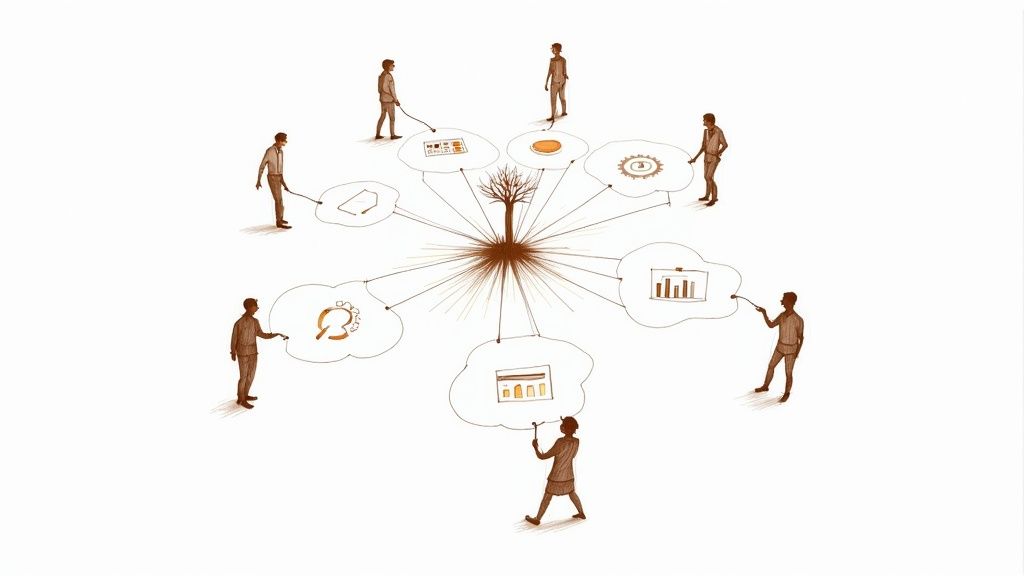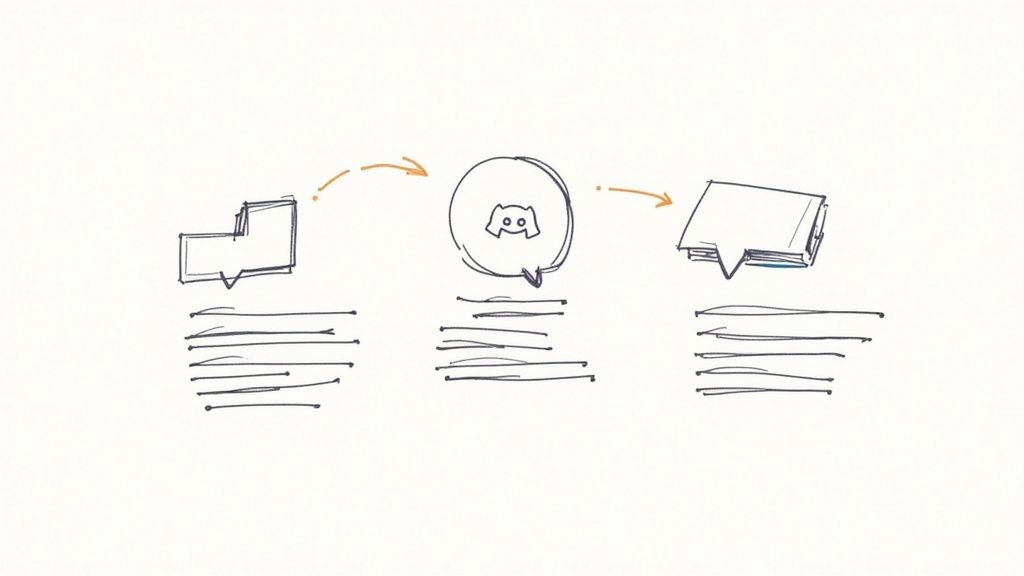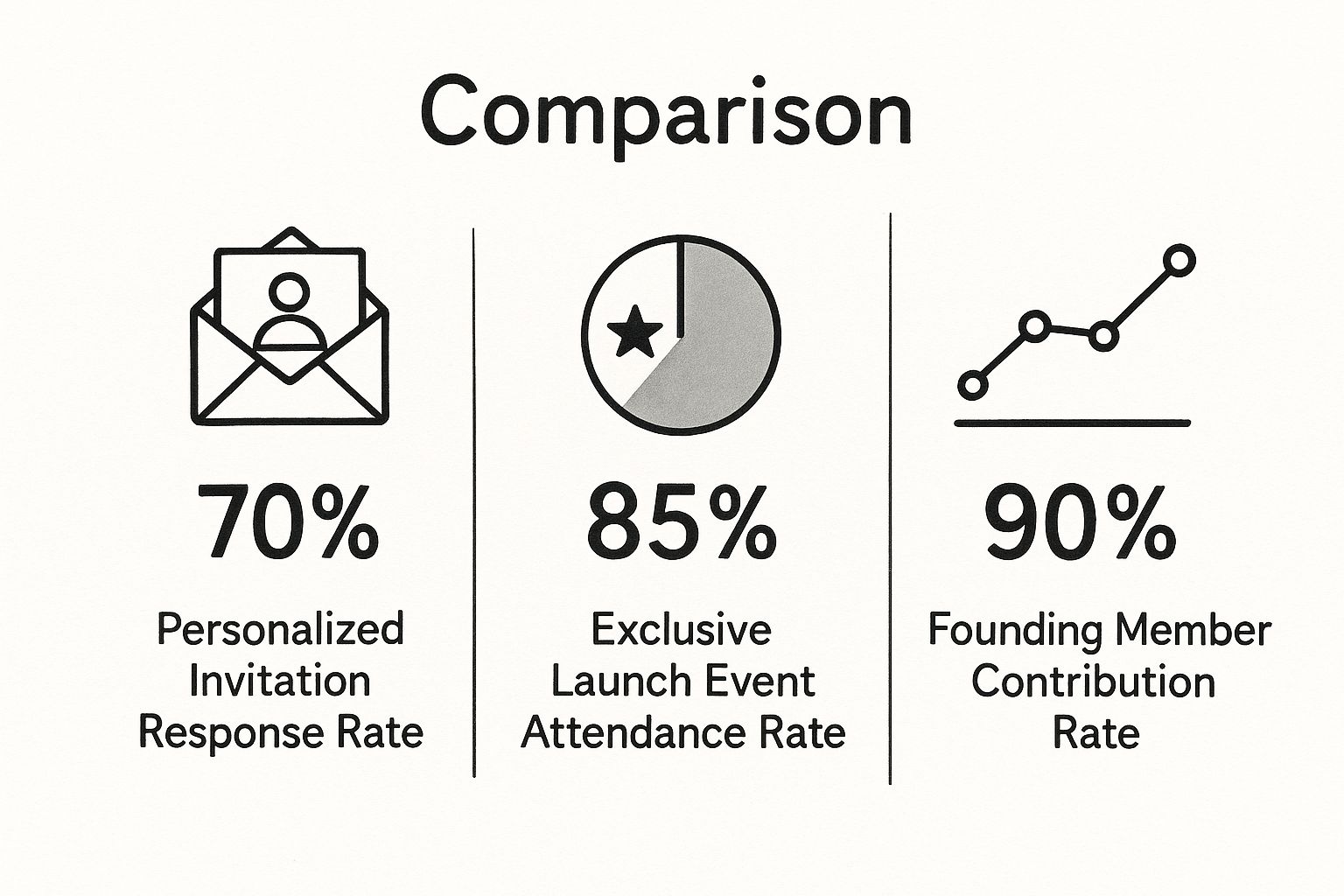October 13, 2025

Before you even think about platforms, invite lists, or content calendars, let's talk about the most important part of building a community: its soul. Every thriving group starts with a clear, magnetic purpose that pulls the right people in. It's about answering two fundamental questions: Why does this group exist, and who is it for?
Nailing this blueprint is the single most critical step. It’s what separates a vibrant, self-sustaining community from an empty digital room.

The real work of community building happens long before you send out the first welcome email. It’s about carving out a specific, meaningful identity that acts like a lighthouse for your ideal members. If you skip this, you risk creating a generic space that fails to hold anyone's attention.
This isn’t about drafting a lofty mission statement. It's about answering practical, human-centered questions. Why should someone give you their incredibly limited time? What specific problem are you solving for them? What shared passion are you bringing to life?
For example, a community for "digital marketers" is far too vague. But a community for "in-house SEO specialists at B2B SaaS companies struggling to get internal buy-in"? That’s specific. It’s targeted. And it immediately signals its value to the right person.
You have to know your members better than they know themselves—or at least, better than their job title suggests. Think of this as creating a detailed persona for the one person you absolutely need in your community.
Go beyond surface-level demographics and dig into their reality:
When you understand these details, you can build a purpose that speaks directly to their needs. Your community becomes the solution they’ve been desperately searching for.
In the early days, community health has nothing to do with size. A group of 50 highly engaged, connected members is infinitely more valuable than 5,000 silent lurkers. Your first goals need to reflect that reality, focusing on interaction over registration.
Forget about aiming for "1,000 members in three months." Instead, set goals like these:
These are the real vital signs of a budding community. They prove people aren't just there to consume content—they're actively building relationships and creating value for each other. To really lay a solid groundwork, it's worth exploring in-depth guides on how to build online community that cover these initial steps and audience growth strategies.
A community's true value isn't in its headcount; it's in the density of its connections. Your first job as a founder is to be the catalyst for those initial sparks between members.
To help you get this right from the start, I've put together a checklist. Think of it as your foundation-building guide.
This simple table will help you crystallize your thinking and ensure you've covered the essentials before you move on to the next phase.
Answering these questions honestly will give you the clarity needed to build something that truly lasts.
Ultimately, this phase is all about building a space founded on trust. In a world where social cohesion feels fragile, creating a trusted environment is paramount. As the United Nations' 2025 World Social Report highlights, trust is deteriorating globally, often fueled by disinformation. Your community can be a small but powerful antidote—a place where genuine connection and transparency can thrive.

The digital home you build for your community does more than just host conversations—it sets the entire tone. It's the architecture of your member experience, influencing how people connect, find information, and ultimately, feel. Just picking the most popular tool on the market can seriously backfire if it doesn't actually fit what your community is trying to do.
This decision isn't just about a checklist of features. It's about finding a platform whose DNA matches your members' needs and natural behaviors. A fast-paced, chat-first environment might be perfect for one group, but it could completely overwhelm another that needs structured, thoughtful discussions.
Before you even think about comparing features, go back to your community's "why." The right platform should feel like a natural extension of your mission, not a clunky tool you have to wrestle with. The goal is to find a space where the interactions you want to see happen with the least amount of friction.
Think about it in these real-world terms:
The platform you choose sends a powerful message about what your community values. A space built around threaded discussions tells members you prioritize deep, lasting conversations. One centered on live chat signals that you value immediate, in-the-moment connection.
While your purpose is the north star, a few key functions are non-negotiable for building a community that can actually grow. Look past the shiny new features and get serious about the foundational tools that will support you and your members day in and day out.
A great platform should feel invisible. It empowers members to connect and engage without them ever having to think about the technology that makes it possible.
Once you've made your choice, the initial setup is your chance to create a welcoming and intuitive environment. Don't just stick with the default settings. Thoughtfully designing your community's layout from the get-go prevents confusion and encourages people to jump in right away.
Here’s where to start:
#introductions is a must-have—it gives every new person a clear first step.Getting this initial architecture right is vital. A well-organized space lowers the mental barrier for new members, making it easy for them to find their footing and start contributing—which is the entire point.
Getting your first hundred members isn't about casting a wide, impersonal net. It’s about being incredibly intentional. Think of it like you're hand-picking the founding team for a startup, not just trying to fill seats at an event.
These first people are everything. They're not just users; they're the co-builders of your community's culture. Their early conversations, their questions, and their general vibe will set the tone for everyone who joins later. Your job is to find people who genuinely get what you're trying to do and are excited to be a part of it from the ground floor.
The best place to find your first members is almost always right under your nose. The people who already know, like, and trust you are your warmest leads. Your personal stamp of approval on this new community means something to them, making it an easy "yes."
Start by digging into your own connections:
Once you’ve got a list, fight the urge to send a mass email blast. A generic message gets a generic response (or no response at all). This is all about a personal, high-touch approach that makes each person feel like they were specifically chosen.
Your invitation is the very first taste of your community's value and culture. It needs to feel exclusive and personal, not like a sales pitch. A killer invitation clearly explains "why now" and what's special about being a founding member.
Here's how I'd structure the outreach:
An invitation to be a founding member isn't just asking someone to join. It's an offer to co-create something meaningful. Frame it as a chance to get in on the ground floor of something special.
This high-touch strategy isn't just a "nice-to-have"—it gets real results.

The data speaks for itself. Making people feel valued from day one leads directly to them showing up and participating more.
Of course, getting them in the door is just the beginning. You have to welcome them properly. Our guide on how to start a community dives deeper into this crucial launch phase. And to make sure they stick around, studying some effective user onboarding practices can make all the difference in keeping those valuable first members engaged for the long haul.

Getting your first members through the door is just the start. The real challenge—and the real fun—begins now. An empty room with a few scattered people isn't a community; it's just a space. The magic happens when you intentionally spark the conversations that turn a collection of individuals into a connected, buzzing group.
Keeping that energy high isn’t about one-off viral posts. It’s about creating a consistent rhythm of value that makes people want to come back. Your job shifts from being a recruiter to a facilitator, creating endless opportunities for members to connect with your purpose, your content, and most importantly, with each other.
The first 48 hours a new member spends in your community are absolutely critical. A warm, structured welcome can be the difference between someone becoming a core contributor and someone who logs in once, gets overwhelmed, and never returns. Please, don't just rely on a generic, automated "welcome to the group" email.
Create a specific welcome sequence that gets them participating immediately. For example, set up a dedicated #introductions channel and prompt new members with fun, specific questions—not just a bland "tell us about yourself."
Try prompts like these to get the ball rolling:
This gives people an easy first step and helps existing members find common ground to start a conversation. As the community leader, your job is to model this by personally replying to every single introduction. It’s a simple act, but it loudly communicates that you care and every member is seen.
A great welcome experience doesn't just onboard a user; it makes a new member feel like they've finally found their people. It's the moment they realize they belong.
A vibrant community needs a steady drumbeat of interesting content and questions. Just sitting back and waiting for others to start talking—especially in the early days—is a recipe for silence. You have to be the one seeding discussions that are genuinely interesting and relevant to your members.
Plan a weekly content calendar with recurring themes. For a community of freelance writers, this could look like:
This kind of predictability creates anticipation and gives members a concrete reason to check in regularly. The trick is to ask open-ended questions that can’t be answered with a simple "yes" or "no." Instead of "Do you like the new software update?" ask, "For those who've tried the new software, what's one surprising use case you've discovered?" You'll find a ton of proven member engagement strategies you can adapt to build out your calendar.
The engagement tactics you use should also evolve as your community does. What works for a brand-new group won't necessarily be the right fit for a mature, self-sustaining one.
Here's a quick look at how to tailor your approach based on where your community is in its lifecycle.
Matching your strategy to your community's stage ensures you're always focusing your energy where it will have the biggest impact.
One of the most powerful ways to fuel participation is to celebrate it. When a member shares a valuable insight, thoughtfully answers another's question, or offers helpful feedback, make a big deal out of it. This simple act of recognition does two crucial things: it makes the contributor feel valued, and it shows everyone else exactly what kind of behavior is prized in the community.
Here are a few easy ways to do this:
When members see their contributions are genuinely valued, they become more invested in the group's collective success. By celebrating participation, you slowly but surely turn passive observers into active co-creators of your community's culture.
If you want to build a community that lasts, you have to get good at listening. Not just to the loudest voices, but to the subtle story your data is telling you about what’s really happening inside your group.
It’s tempting to run a community based on gut feelings alone, but that's a recipe for burnout and missed opportunities. A data-informed approach, on the other hand, helps you see what's working, what isn't, and where to invest your precious time and energy. This is the difference between simply managing a group and strategically building an ecosystem that people genuinely value.
First things first, we need to stop obsessing over vanity metrics. These are the numbers that look great in a report but don't actually say anything meaningful about your community's health.
A truly healthy community thrives on the quality of its interactions. To see that, you need to track actionable KPIs (Key Performance Indicators) that reflect real participation. Platforms like GroupOS are designed specifically to pull these crucial insights to the surface, so you can focus on what actually moves the needle.
If you want to dive deeper into which numbers to watch, check out our guide on essential community engagement metrics.
To get a real pulse on your community, you need to track metrics that measure activity and connection. These are the numbers that show you how members are behaving and if they're actually building relationships with each other.
You don't need a massive dashboard. Just focus on a few core indicators to start:
Tracking these numbers helps you spot patterns you’d otherwise miss. Maybe you notice engagement always spikes on Tuesdays after you post a certain kind of question. That’s not a coincidence; it's a signal to do more of that.
Data isn't just about reporting on what happened last month. It’s about getting clear signals on how to build a better future for your community. It turns guesswork into informed action.
Once you know what to measure, the key is to create a simple, repeatable process for looking at the data. You don't need a complex analysis—a monthly "health check" is often all it takes to stay on track.
During your review, just ask a few straightforward questions:
This isn’t just a numbers game; it’s about connecting the dots between data points and human behavior. It creates a powerful feedback loop that helps you refine your content, sharpen your engagement tactics, and ultimately serve your members better. This evidence-based approach reflects a wider trend, like how organizations use data from the Social Progress Index to make informed decisions that improve lives. By using your own community's data, you’re applying that same powerful principle on a micro scale.
Let's be honest: building a community from scratch comes with a lot of questions. As you move from the big-picture planning to the day-to-day reality of engaging with members, you're bound to hit a few bumps. This section is all about tackling those common hurdles head-on.
Think of this as your practical field guide. We’ll cover the stuff that might keep you up at night—from how much time this really takes to handling those tricky member dynamics. Let's get you the answers you need to lead with confidence.
This is one of the first questions everyone asks, and the real answer is: it depends on the stage you're in. Your community needs you most right at the beginning.
For the first three to six months, you should budget for 10-15 hours per week. This isn't just about passively checking in; it’s about active, hands-on facilitation. You're the one personally welcoming every single new person, starting discussions from scratch, and hosting those first few events to build momentum. It's a lot, but this early effort pays off big time.
Once your community starts to find its own rhythm—when members start answering each other's questions and kicking off their own conversations—your role can evolve. You’ll probably find your time commitment drops to around 5-8 hours per week, shifting your focus to high-level moderation, future planning, and empowering your most engaged members to become leaders.
The sound of silence in a new community can be terrifying, but don't panic. It's a super common problem, and it's totally fixable. The key is realizing that engagement rarely just happens on its own at first. You have to create it.
So, you've posted a great discussion prompt and... crickets. Instead of just letting it die, get proactive.
Remember, in the beginning, you're the host of the party. It's on you to make the introductions and get conversations going until your guests feel comfortable enough to mingle on their own.
A quiet community isn't a failed community; it's an unprompted one. Your initial role is to be the catalyst, repeatedly creating easy opportunities for members to connect until it becomes a habit.
The free vs. paid debate is a big one, and there's no single right answer. It all comes down to what you're trying to achieve. Each model has its strengths, and sometimes, a mix of both is the smartest play.
A free community is fantastic for building brand awareness and reaching a wide audience. You're lowering the barrier to entry, which lets you attract a ton of people and establish yourself as an authority in your space. Think of it as the top of your funnel.
A paid community, on the other hand, immediately filters for commitment. When people have skin in the game, they're far more likely to show up and participate. That revenue also gives you the resources to invest back into the community with better content, exclusive events, and more powerful tools.
Many of the most successful communities use a hybrid model: a free, public space with a paid tier for premium access. This lets you have the best of both worlds. Your paid tier could include things like:
This setup lets you build a massive audience while creating a sustainable, high-value experience for your most dedicated supporters.
Sooner or later, it will happen. Conflict is a natural part of any group of humans, and the way you manage it will say everything about the culture of your community. If you ignore it, it won't just go away—it'll fester and drive away your best members.
Your first and best defense is a set of clear, visible community guidelines that are in place from day one. These aren't just legal formalities; they are the constitution of your community, giving you a firm foundation to stand on when things get messy.
When a conflict pops up, deal with it quickly and, whenever you can, privately. Calling people out in a public thread is a recipe for disaster. Instead, send a private message to each person involved to hear their side of the story without making them feel defensive.
Your goal isn't always to mediate a perfect resolution. It's to uphold the community's standards. Gently but firmly reiterate the guidelines and explain why certain behavior crossed a line. And don't be afraid to remove people who repeatedly break the rules. Your number one job as a leader is to protect the psychological safety of the entire community.
Building a thriving community is a marathon, not a sprint. By staying focused on your purpose, picking the right tools, and engaging with intention, you can create a space that delivers incredible value for years to come. GroupOS gives you the all-in-one platform to manage your members, events, and content, so you can focus on what you do best: fostering connection.
Ready to build, manage, and scale your community with a single powerful tool? Explore GroupOS today.


